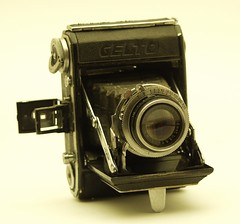Semi Gelto
The Semi Gelto is a series of Japanese 4.5×6 folders made by Tōa Kōki, distributed by Hattori Tokei-ten from 1941 to 1944, and again by Taiyōdō in the late 1940s.
Contents
General description
The Semi Gelto is a vertical folder, with straight diagonal struts, engraved N.T on the root. The finder is to the right, as seen by the photographer holding the camera vertically — this is the reverse of the usual arrangement. There is a body release actioned by the right hand finger. The film is advanced by a knob or a key on the left of the viewfinder. The back is hinged to the right. The name GELTO is embossed in the front leather.
All the models have Grimmel f/3.5 and f/4.5 three-element lenses, made by Fujita Kōgaku Kikai.[1]
Advertisements and other documents
The Semi Gelto is already mentioned in the official list of set prices compiled in October 1940 and published in January 1941, under the names "Semi Gelto I" (¥74) and "Semi Gelto II" (¥88).[2] The same versions also appear in a similar price list dated November 1941, together with a "Semi Gelto S".[3] The camera is attributed to Tōa Kōki in the latter document.
In an advertisement in Shashin Bunka October 1942,[4] the Semi Gelto is still presented as a new product, "sister of the Gelto", and three versions are listed:
- Semi Gelto I: Grimmel 7.5cm f/4.5 lens, Gelto-I shutter giving T, B, 5–250 speeds (¥87);
- Semi Gelto II: Grimmel 7.5cm f/4.5 lens, Gelto shutter, speeds from 1s to 1/200 (¥104);
- Semi Gelto S: automatic film advance, Grimmel 7.5cm f/3.5 lens, Gelto shutter, speeds from 1s to 1/200 (¥170).

|
| Semi Gelto in Photo Art December 1949. (Image rights) |
The Semi Gelto is also mentioned in the government inquiry listing Japanese camera production as of April 1943.[5] Two versions appear, one has a Grimmel 75/4.5 and an unknown shutter, the other has a Grimmel 75/3.5 and a Yamato Rapid shutter made by Yamato and giving T, B, 1–500 speeds, the same as on the Baby Leotax.[6] Advertisements are reported in Japanese magazines until March 1944.[7]
It seems that the Semi Gelto was still distributed in the late 1940s. The camera is mentioned in an advertisement in Kohga Gekkan May 1948 by Taiyōdō (the distributor of the Gelto 3×4cm model in the late 1940s).[8] This might indicate that the production was resumed in small quantities. The article on Japanese cameras in the December 1949 issue of Photo Art shows a picture of the camera (the same as in the October 1942 advertisement), but this document possibly lists some discontinued models.[9]
Actual examples
Semi Gelto I and II
The Semi Gelto I and Semi Gelto II are recognized by their folding optical finder.[10] Variations are known in the film advance control and in the position of the red window.
Some cameras have a hinged advance knob, which can be used as a key when unfolded, with two arrows indicating the winding direction. This is the version pictured in the October 1942 advertisement and in the December 1949 column. Actual examples are known with an f/4.5 lens and a Gelto I shutter, giving T, B, 5–250 speeds and engraved GELTO–I at the base of the rim,[11] or with an f/3.5 lens and a different shutter giving T, B, 1–300 speeds.[12]
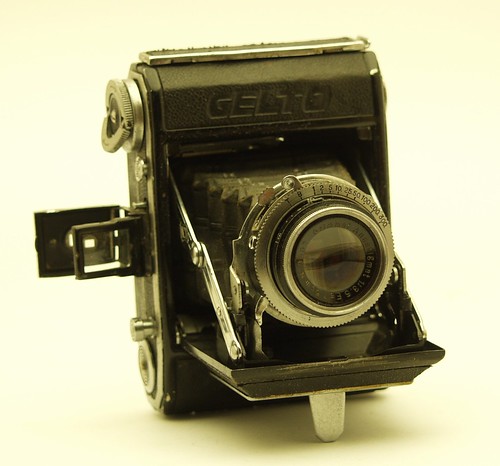
|
| Semi Gelto, hinged advance knob, Grimmel Anastigmat 7.5cm f/3.5 lens no.9887, no-name shutter (T, B, 1–300). Picture courtesy of Heinz Veddeler. (Image rights) |
Other cameras have a regular advance knob, with a round patch of leather in the middle. Some have the red window at the top right of the back; the example pictured in this page has a Gelto-I shutter (T, B, 5–250) and a Grimmel Anastigmat 7.5cm f/4.5 lens.[13] At least one example is known with the same lens and shutter combination and the red window at the top left.[14]
 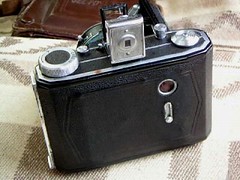
|

|

| |
| Semi Gelto, plain advance knob, Grimmel Anastigmat 7.5cm f/4.5 lens, Gelto-I shutter (T, B, 5–250). Pictures courtesy of eBayer 29below. (Image rights) | |
Finally, at least one example is known with a simple advance key and the red window at the top right of the back.[15] This particular example has a Rieze-Anastigmat 7.5cm f/3.5 front-cell focusing lens, mounted on a B, 1–300 shutter inscribed KRAFT–WORKS at the base of the speed rim. The Rieze lenses have three elements and were made by Fujita Kōgaku Kikai (as the Grimmel). They were normally mounted on the Semi Leotax. The Kraft shutter is normally found on the Kraft camera. Despite the maximum aperture of the lens, the aperture scale only goes from 4.5 to 22 and this equipment is probably not original.
Semi Gelto S
 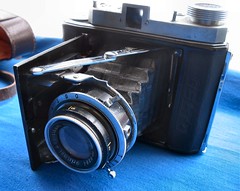 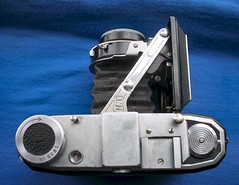
|
  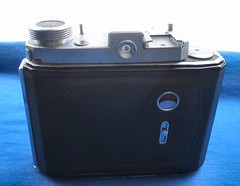
|
| Semi Gelto S no.6681, Grimmel Anastigmat 7.5cm f/3.5 lens no.8394, OSTN shutter (T, B, 1–300). Pictures courtesy of eBayer mystic_kitchen. (Image rights) |
The Semi Gelto S has a top housing containing the viewfinder and the automatic film advance mechanism.[16] The shutter release and the folding bed release protrude from the top housing, on the right and on the left of the viewfinder. The accessory shoe is above the top housing on the right. The advance knob has a round leather patch, an arrow and perhaps the body serial number are engraved on the rim. There is a round hole on the right of the knob, certainly for an exposure counter. The advance unlock lever is on the back of the top housing, to the extreme left. There is a red window in the top right of the back, protected by a vertically sliding cover, to set the position of the first exposure.
The lens is a Grimmel Anastigmat 7.5cm f/3.5 with front cell focusing. Most examples observed have a Gelto II shutter providing T, B, 1–300 speeds, engraved GELTO–II at the base of the rim.[17] One example, pictured in this page, is known with another shutter (T, B, 1–300) engraved OSTN at the base of the speed rim.[18] Another example is known with an NKS shutter engraved NKS TOKYO, probably giving B, 1–200 speeds (the top speed is barely legible).[19]
Notes
- ↑ "Kokusan shashinki no genjōchōsa" ("Inquiry into Japanese cameras"), lens items Lb6 and Lc10.
- ↑ "Kokusan shashinki no kōtei kakaku", type 3, sections 4A and 6A.
- ↑ "Kamera no kōtei kakaku kanpō happyō", November 1941, type 3, sections 4A, 6A and 7B.
- ↑ Advertisement reproduced in Kokusan kamera no rekishi, p.70.
- ↑ "Kokusan shashinki no genjōchōsa" ("Inquiry into Japanese cameras"), items 46 and 47. The lens code Lc6 for item 47 is clearly a typo for Lb6.
- ↑ "Kokusan shashinki no genjōchōsa" ("Inquiry into Japanese cameras"), shutter item 18-R-10.
- ↑ Kokusan kamera no rekishi, p.336.
- ↑ Advertisement in Kohga Gekkan May 1948, reproduced in Awano, p.5 of Camera Collectors' News no.239. Note: 1. This date cannot be correct, since the first post-war publication of Kohga Gekkan was January 1949. 2. There is no evidence that Taiyōdō was anything other than a Tokyo shop selling Gelto cameras along with other used cameras.
- ↑ Photo Art December 1949, p.36.
- ↑ They certainly correspond to the model called "Semi Gelto (1939)" in McKeown, p.922.
- ↑ Example pictured in Sugiyama, item 1068, example pictured in Omoide no supuringu-kamera-ten, p.27 (lens no.4080), and example observed in an online auction.
- ↑ Example pictured in this page (lens no.9887).
- ↑ Example pictured in this page, and example observed in an online auction (shutter type unknown).
- ↑ Example observed in an online auction, body no.5207 (reportedly), lens no.6337. See also the example pictured in Tanaka, p.7 of Kurashikku Kamera Senka no.8 (the position of the red window is unknown).
- ↑ Example observed in an online auction.
- ↑ It is called "Semi Gelto (Later Version)" in Sugiyama, item 1069, and it is certainly the model called "Semi Gelto (1940)" in McKeown, p.922. The date of 1940 is wrong.
- ↑ Example pictured in Sugiyama, item 1069 (the 1/200 top speed reported in the text is belied by the picture); example pictured in this page (archived) at Japan Family Camera (lens no.2578); example offered for sale by a Chinese dealer; examples observed in online auctions (lens no.6157 and no.8176).
- ↑ Example pictured in this page (lens no.8394).
- ↑ Example observed in an online auction, lens no.3380.
Bibliography
Original documents
- "Kamera no kōtei kakaku kanpō happyō" (カメラの公定価格官報発表, Official announcement of the set prices of the cameras), November 1941. Extract of a table listing Japanese camera production and setting the retail prices, reproduced in "Bebī Semi Fāsuto 'Kore ha bebī wo nanotta semi-ki da'" (ベビーセミファースト"これはベビーを名乗ったセミ機だ", Baby Semi First, 'this is a Semi camera called Baby'), an article by Furukawa Yasuo (古川保男) in Camera Collectors' News no. 277 (July 2000). Nishinomiya: Camera Collectors News-sha. P. 27. Type 3, sections 4A, 6A and 7B.
- "Kokusan shashinki no genjōchōsa" (国産写真機ノ現状調査, Inquiry into Japanese cameras), listing Japanese camera production as of April 1943. Reproduced in Supuringu kamera de ikou: Zen 69 kishu no shōkai to tsukaikata (スプリングカメラでいこう: 全69機種の紹介と使い方, Let's try spring cameras: Presentation and use of 69 machines). Tokyo: Shashinkogyo Syuppan-sha, 2004. ISBN 4-87956-072-3. Pp.180–7. Items 46–7.
- "Kokusan shashinki no kōtei kakaku" (国産写真機の公定価格, Set prices of the Japanese cameras), listing Japanese camera production as of October 25, 1940 and setting the retail prices from December 10, 1940. Published in Asahi Camera January 1941 and reproduced in Shōwa 10—40nen kōkoku ni miru kokusan kamera no rekishi (昭和10〜40年広告にみる国産カメラの歴史, Japanese camera history as seen in advertisements, 1935—1965). Tokyo: Asahi Shinbunsha, 1994. ISBN 4-02-330312-7. Pp.108—9. Type 3, sections 4A and 6A.
- Photo Art December 1949. "Ōru kokusan kamera" (オール国産カメラ, All of Japanese cameras). Pp.34–41.
Recent sources
- Asahi Camera (アサヒカメラ) editorial staff. Shōwa 10–40nen kōkoku ni miru kokusan kamera no rekishi (昭和10–40年広告にみる国産カメラの歴史, Japanese camera history as seen in advertisements, 1935–1965). Tokyo: Asahi Shinbunsha, 1994. ISBN 4-02-330312-7. Item 99.
- Awano Mikio (粟野幹男). "Meteōru, Besutokamu, Epokkusu" (メテオール、ベストカム、エポックス, Meteor, Vestkam, Epochs). In Camera Collectors' News no.239 (May 1997). Nishinomiya: Camera Collectors News-sha. (Shows a reproduction of an advertisement in Kohga Gekkan May 1948 mentioning the Semi Gelto.)
- McKeown, James M. and Joan C. McKeown's Price Guide to Antique and Classic Cameras, 12th Edition, 2005-2006. USA, Centennial Photo Service, 2004. ISBN 0-931838-40-1 (hardcover). ISBN 0-931838-41-X (softcover). P.922.
- Omoide no supuringu-kamera-ten (思い出のスプリングカメラ展, Exhibition of beloved self-erecting cameras). Tokyo: JCII Camera Museum, 1992. (Exhibition catalogue, no ISBN number.) P.27.
- Sugiyama, Kōichi (杉山浩一); Naoi, Hiroaki (直井浩明); Bullock, John R. The Collector's Guide to Japanese Cameras. 国産カメラ図鑑 (Kokusan kamera zukan). Tokyo: Asahi Sonorama, 1985. ISBN 4-257-03187-5. Items 1068–9.
- Tanaka Masao (田中政雄). "Sonota no nihon no supuringu-kamera" (その他の日本のスプリングカメラ, "Other Japanese folding cameras"). Kamera Rebyū: Kurashikku Kamera Senka (カメラレビュー クラシックカメラ専科) / Camera Review: All about Historical Cameras no.8, September 1986. No ISBN number. Supuringu kamera (スプリングカメラ, special issue on spring cameras). Pp.76–80.
Links
In Japanese:
- Semi Gelto S at Japan Family Camera (archived)
